- Home
- Anna Kavan
Sleep Has His House Page 10
Sleep Has His House Read online
Page 10
The flowers and the birds between them, helped by the sun and the pleasant light breeze, have made a natural paradise which it is impossible to imagine as being invaded by anything evil or cruel or frightening or even sad. And to crown all this it must be a fête day as well. The low grey tower of the church, so old that it seems to have sunk into itself under the weight of the centuries, is now enlivened by the gaudy brightness of flags. Flags are fluttering over the vicarage and the manor and the school and the post office and out of the cottage windows.
The inn at the foot of the hill has other decorations besides the large flag the shadow of which dances over the grass outside. Wreaths and garlands of flowers, as well as fresh branches and coloured streamers, are fastened above and around the two open doors and the porch and the squat bow windows. Some agile person has even climbed up the pole of the inn sign and fastened a great loose bundle of honeysuckle to the iron scrolls supporting the board upon which a nameless rural artist has painted the likeness of some heraldic beast. The inn itself is a long low mellow building that seems to smile. And it’s quite right that it should have this smiling look because it’s the centre of all the gaiety, the headquarters, so to speak, of the message which the flowers and the birds have been spreading so diligently ever since the sun rose on this happy morning. Inside, a lively bustle of preparation is going on. Just now the doors set invitingly open don’t reveal much except high-backed settles and white sanded floors: but from time to time one catches a glimpse in the background of a figure hurrying past with a tray of good things, hams, cheeses, fruit, or a basket of crusty loaves hot from the oven, indications of the feast to be served later in the day.
At present all the activity centres out of doors, where a sort of impromptu pageant seems to be going on. Under the chestnut tree on the green a number of benches and tables have been set out, and here people are sitting with tankards of cider and ale, an audience for the panting, beaming maypole dancers with their whirling smocks and ribbons, and for the group of children who are singing a folksong in reedily cheerful disunison.
The black-coated clergyman, like an approving sheepdog, smiles at the innocent antics. And a party of local gentry also looks on from the platform festooned with meadowsweet and with white, pink and scarlet may.
To the left of the platform, among other young people, a girl in green shoes is holding a great dog on a leash plaited with vivid cords. It looks as if she and her companions, with whom she is laughing and talking, will have some part to play later on. They stand there together with faces of excited expectancy; and the dog seems to share their pleasure, as he flourishes his whiplike tail and prances in anticipation.
The children’s chorus falters unevenly to a close. Flushed and gasping, with a jingling of little bells at their ankles and wrists, the dancers laughingly troop away from the pole around which their variegated ribbons are left tightly twined. The audience claps, mugs are banged on the tables, a waitress in a check apron comes out carrying in both hands a huge foaming jug, the clergyman hurries here and there with directions and praise. For a minute or two the green is in confusion, before what must surely be the turn of the girl with the dog and her friends.
But she, all at once, at this critical moment becomes distrait. Her eyes wander. She is not looking any more at what’s taking place, but at something everyone else is too preoccupied to observe, a woman in black who is slowly coming towards the inn from the direction of the churchyard. Slowly but steadily the stranger comes on, unnoticed, and taking no notice of anything. She does not look right or left and her face is not seen. She walks as if meditating, with bowed head, and with hands loosely linked at the ends of her long black sleeves. In the sun a sapphire flashes blue on her finger: it is the only colour she wears anywhere about her. She slowly passes the green, making for the road that leads upwards into the hills
followed at a little distance by B, who lets the dog’s lead fall and, unobserved by her companions, slips away through the crowd, in the wake of that dark and impassive form.
Come, they said, the co-operators, the false ones. Come and sit with us tonight, we are having a friendly discussion (to fit the universe into pigeon-holes), quite informal of course, and a nice warm kiss, at sunrise, to finish the party. There will be a place waiting for you. And this sweet brew which contains soothing syrup is something to warm the cockles and to make you cosy. Let’s be cosy together. Draw the curtains. Make up the fire. Don’t look out of the window. Why do you want to look out? It’s dark and cold out there, so let’s settle down to be comfy and to discuss the shadow of Emerson’s Man.
Night time: a spirit of festivity is again in the air. And though it is not the idyllic Arcadian gaiety of the pastorale but something more sophisticated, more artificial, still there’s an atmosphere of expectancy and joyous excitement gleaming from the eyes of street lamps and lighted windows. In fact it is a city of lights, the whole dream is ablaze with light, the whole sky is one vast shimmering aurora borealis of reflected brilliance. It’s impossible to tell whether the stars are out or whether the moon is shining. All one sees in looking over the housetops is a diaphanous aerial curtain of wonderfully blended hues, red, orange, yellow, green, blue, indigo, violet, the whole spectrum extended and repeated from horizon to horizon like an endless series of rainbows in tremendous array. And on top of this, as if such a display wasn’t dazzling enough, over the glimmering folds of the resplendent light-curtain, strange wavering bands of pure white luminosity flicker and weave strands so incandescent that they appear to be glowing with limpid fire.
It’s really too much of a strain on the eyes, one can’t look upwards for long. Not that there is any contrasting dimness below. The streets are as bright as day, for the numerous street lights on normal duty are for this special night reinforced by countless additional flares, torches, links, blazing braziers, relics of ancient times which have perhaps been preserved and stored for the purpose of being resurrected on occasions of this sort. Nearly every window, too, seems to be pointing its burning finger into the night; for few people have thought of drawing the curtains.
At the palace a state ball is in full swing. The great building, with every window aflame, rides the night like an enormous ship, isolated as it is from the glaring streets in a dim sea of encircling gardens where only the fairy-lights show a pale luminous phosphorescence among the trees and the sleeping roses. It is tempting to linger in these cool shadowed walks drowsy with the heavy scent of night-stocks and tobacco flowers. Hidden away at the edge of a lily pool is an arbour where the glow-worm globe silvers the cheek of a gardenia and the folds of a lady’s gown. Accompanied by the faintest rustle of silk, a pair of lovers drifts past the little statue who holds up his cornucopia full of a pretty paleness of flowers or snow.
But here is the wide sweep, deserted now, where recently arriving guests thronged beneath tasselled awnings; where still the guards stand frozen in their grand uniforms, the powdered lackeys no less immobilized beyond.
There’s no need to describe the splendours of the palace; the statues, the winging staircases, the columns, the balustrades of marble and onyx and agate and porphyry. What’s the use of talking about the grandeur of the ballroom, the elegance of the dancers, the skill of the orchestra? Such things are better left to the imagination so that everyone can fill in for himself such details as he finds most satisfactory. Just as we can all picture the magnificent banquet overflowing with choicest wines, fruits, rare dishes of all descriptions, sanglier, sturgeon’s roe, peacocks stuffed with peaches, or whatever seems most delectable and exotic.
Only as regards the ballroom it is necessary to mention the elaborate chandeliers (if that is the right term with which to describe these sparkling crystal confections of ice-bright lights, fantastically crownshaped, and pouring an absolute flood of brilliance upon the scene). It is these amazing illuminations which give the ballroom such a unique distinction; for they are quite unforgettable; and a person who has once seen them is not likely
to be much impressed by any other wonder encountered in his travels about the world
which makes all the more surprising the potency of the attraction that draws the girl with the glistening green glass slippers to leave her partner standing thunderstruck immmediately under one of the radiant crowns in order to follow a silhouette darkly beckoning and window-framed in the sapphire recessive night.
And so on: in considerable repetition, with varying detail, of the basic situation; the central theme itself being subject to variation in so far as the attraction is not inevitably to darkness from light.
For instance; the dream travels, quite briefly, through a picture sequence in which each view lasts only just long enough for apperception before it is superseded.
At first there is seen, from some distance away, a small one-storey house near the edge of a forty-foot cliff, at night; it is not very dark. The shut box of the house, with snaky convolutions of surrounding tree-trunks, is at the top of this picture: the rocky cliff face (below it the tarry water) is the crucial centre. Next a glimpse of the interior in which (in bedroom with drawn blinds) an indication is made of someone asleep in bed: the indication further extended to suggest B. Quick shift outside again to the night sky pricked with a few stars. Huge storm-clouds gathering, expanding, immediately eat up the sky and its stars. The sea rising: the heaving sea-mass bursts into white horses; the wind lets fly; the wind pitched so that its noise is too the hissing spray blown from the breakers which now are filling the dream picture. The cliff is black shadow. A wave crashes; against the rocks the waves hurling a deadwhale-deadweight of water; the spray unfurls its enormous fan; the rocks quake amongst rush and lather and foam of retreating water; their stubborn, drowned, again battered, not yet quite smothered heads (did they really tremble?); upthrusting spray jets higher and higher from the successive breakers. Terrific waves swelling; huger, fiercer waves accumulating and exploding: a wave pounds on a balanced rock; the rock lurches with thunder-thud into the seething sea trough: another pounding thunder-roar, and the cliff quivers with tremor of walls in bombardment.
A lightning flash is stabbed into the sky and jabbed at by other flashes, their crazy neons jittering into word shapes, WHAT IS LOST NOW IS OUR HOME IN THIS WORLD. Immediate glimpse of monstrous vicious crocodile snouts thrusting out of the waves and flaming, fire-belching with deafening shattering booming reverberation and blinding eye-thunder (black and fire everywhere); could be warships, submarines, could be leviathans in their death-throes.
Now the cliff, in black-and-white flaps of fire and thunder, bashed and battered by waves and beaten to breaking-point; rocks, a whole buttress, loosen with earthquake rumble, start to slither; a whole segment of the cliff crumbles and falls away, bearing with it a tree, torn-up roots wildly writhing; the house hanging suspended, projecting over the now concave cliff verge, overhanging nothing.
Inside the bedroom, the sleeper has woken. In this dark room a stirring movement, the door opening, someone entering. Hands, frailly phosphorescent, extended, groping, delicately contacting the edges of furniture, feeling their way like blind hands. A blue ring flashes; two hands are joined, one leading the other, and flashing its bright ring; the hands moving through the dark house together, in darkness, out of the house; leaving it:
outside the tumult speeds up, the storm noise getting steadily madder; the flaming monsters vomiting more and more frenziedly, blasting each other; finally wrecked and ruined and sinking, sizzling in sparks and white-hot seethe of lightning and steaming sea:
with deafening roar the entire cliff crumbles, collapses; the house curtseys, sinking forward slowly, turns over, slowly and gracefully disintegrates (walls fall outwards like sides of cardhouse), disappears.
The pandemonium is dimmed quickly into sound of rushing wind; dull, heavy and broken thumping of waves subsiding; then silence.
Two vague figures, one leading the other by the hand, seen receding far off under the quiet night sky where a few watery stars are starting to reappear.
A most remote, primordial scene. A large expanse of mountainous country, no trees, no water, no habitations. Although there are no really high peaks in sight one gets somehow the impression of being at a high altitude, on a plateau among the tops of the mountains. The rock formations are flattish, truncated, the higher tors assuming the shapes of miniature Table Mountains. The colouring a uniform cool lichen-grey.
The sun has just set and the sky is still faintly pink in the west behind a low blurring dust-haze; elsewhere it is a very limpid and unimpassioned shade of delicate lime-green. In the segment of sky opposite the sunset, above the crenellated horizon, a star, at first only just visible, growing momentarily brighter, assumes an elongated shape like a candle-flame. It is at first the only star to be seen: but very soon another, another, and then another, make their appearance. Towards this cross-shaped constellation, across the plateau in the fading light, a procession of vaguely feminine forms moves slowly on foot. The leader raises her hand in encouragement or in exhortation, points to the four stars. So swift is the passing of the subsequent flash that it is impossible to say whether ring or stars originated the light.
The pilgrimage continues to follow the stars which grow larger and brighter, more strangely shaped
until they reveal themselves as candle-flames in a small dark room with no windows or doors visible. The walls are scrawled over with dimly-seen symbols, pentacles, wands, swords, etc. There are shelves of books: a few phantom-glimmering shapes of vases or urns. B sits on the floor, reading by the light of the four candles set in their cross-shaped holder.
The Liaison Officer in his smart uniform is preparing to read out of his book again. There is the impression hanging about the dream that he has just finished a part of his lecture or sermon or whatever it is, and is about to start on something new. This he does, by reading in a clear cold voice which has perhaps grown somewhat more authoritarian in its inflexion.
Many people have said that retreats are undesirable and that they should be abolished because their existence constitutes a threat to the supremacy of the authorities whose powers ought to be absolute. But when a man says that he is going into retreat it does not mean he is evading the law, which is an impossibility anyhow: it means that he is effecting a change of authority, a transfer from one set of laws to another set at least equally mysterious and severe—so that he is certainly not making an escape of any sort. All that these retreats do is afford an alternative code, no less exacting and quite as incomprehensible as the one held in more general observance. But when it comes to the attitude of the authorities towards such institutions—here, I think, we are getting out of our depth.
In this connection it could be argued: if the authorities really are supreme, why should they permit the continued existence of a system which competes with their own? Is it not much more likely that the retreats are licensed by the authorities because, in some inscrutable way, they play their part in the established order?
There is even the possibility that the regime of the retreats, although it appears (superficially at least) totally different, is nothing but a disguised version of the regulations in force outside. This theory, improbable as it sounds, is supported by the fact that in certain contingencies the two spheres of authority indubitably converge, and perhaps even merge into one another if the critical nature of the emergency warrants it. But these eventualities are so rare and so little understood, the whole subject is so complicated by ambiguity and obscurity, that speculation is necessarily vague.
Actually, one is tempted to believe that the authorities are so perspicacious, so ingenious, that they have devised this method of tricking into conformity with the law people who might otherwise prove recalcitrant and badly adjusted. It is easy to see how a person of this type, thinking only of his own idiosyncrasies, would fall into the trap. He imagines that by going into retreat he will change his allegiance. And, indeed, once he is inside he becomes docile and content, believing that the old authoritie
s control him no longer.
Meanwhile they, in a stronger position than ever, merely congratulate themselves on the success of their stratagem. The fact that their victory has been won in secret is immaterial; why should they, being all-powerful, wish to make an open display of their powers? All that they wanted has now been skilfully and pacifically achieved.
I hid my face in the lap of darkness like a lost child brought at last to his mother. Never again would I stray into the light: never again would I trust myself to a place where even those who sold their birthright for safety were not secure.
THE DREAMSCAPE languidly opens up. Conspectus of university town; early morning mist slowly clearing. The mist dispersal not mere evaporation but a sort of gradual unswathing, very gentle protracted tearing, rolling up and discarding, as of webs or excessively fragile tissue paper, disclosing buildings in careful succession. This process, though necessarily long-drawn out, progresses methodically with a certain businesslike efficiency. Enough should be seen of it to suggest the practised unpacking and setting out of, say, a stock of valuable china.
View narrows to disclosure, from the ground upwards, of one particular tower. As mist wrappings are removed, there appears, on a carved ledge, a row of plump pigeons fast asleep with heads under their wings. Then, sighted up the shaft of the tower as if from its foot, the remote rococo summit, which in a second starts to revolve, discharges a musical-box carillon of tinkling notes which dance off, frisky white minims and semibreves, into the now blue sky. Back for a moment to the pigeons, untucking themselves, yawning, blinking, sleepily stretching their wings.
Now a switchover to an outlying residential street of the same town. Ahead, set back from the road in small flowerless lawn garden, a new white flat-roofed modem house, determinedly unembellished, simple rectangles superimposed like a construction of nursery building blocks. A path of concrete slabs leads to the front door which has a chromium ring, O-shaped, instead of a handle.

 Machines in the Head
Machines in the Head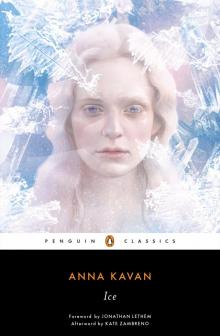 Ice
Ice Who Are You?
Who Are You?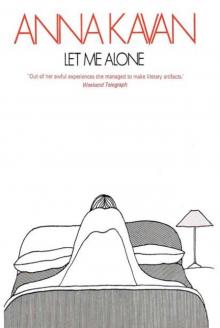 Let Me Alone
Let Me Alone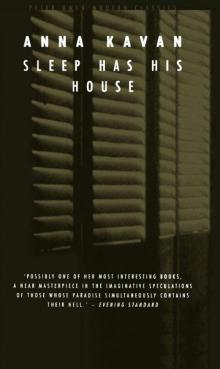 Sleep Has His House
Sleep Has His House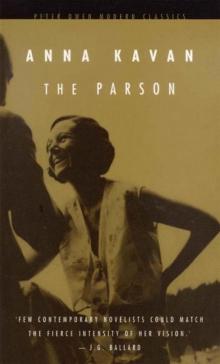 The Parson (Peter Owen Modern Classic)
The Parson (Peter Owen Modern Classic)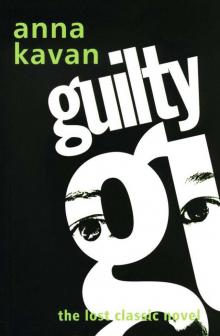 Guilty: The Lost Classic Novel
Guilty: The Lost Classic Novel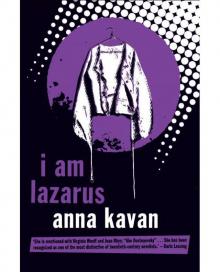 I Am Lazarus (Peter Owen Modern Classic)
I Am Lazarus (Peter Owen Modern Classic)